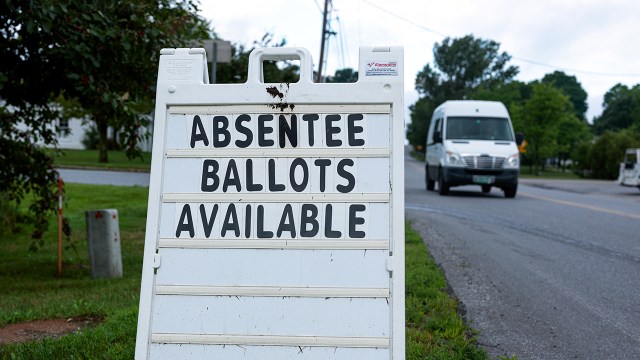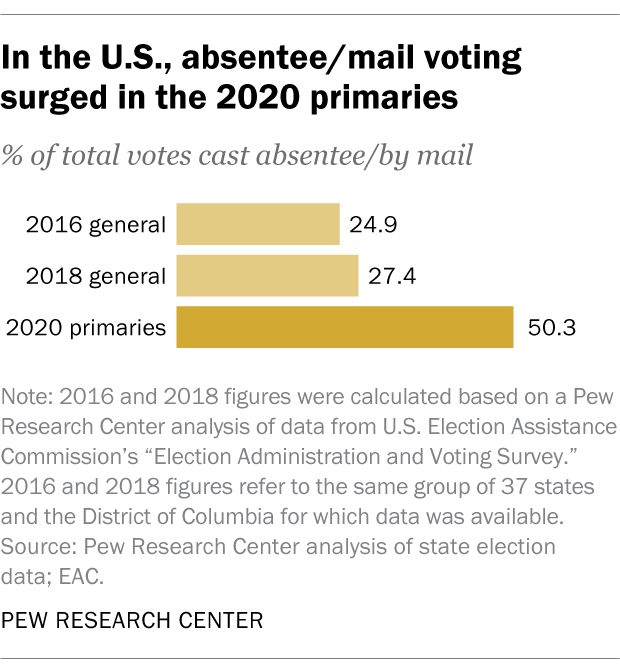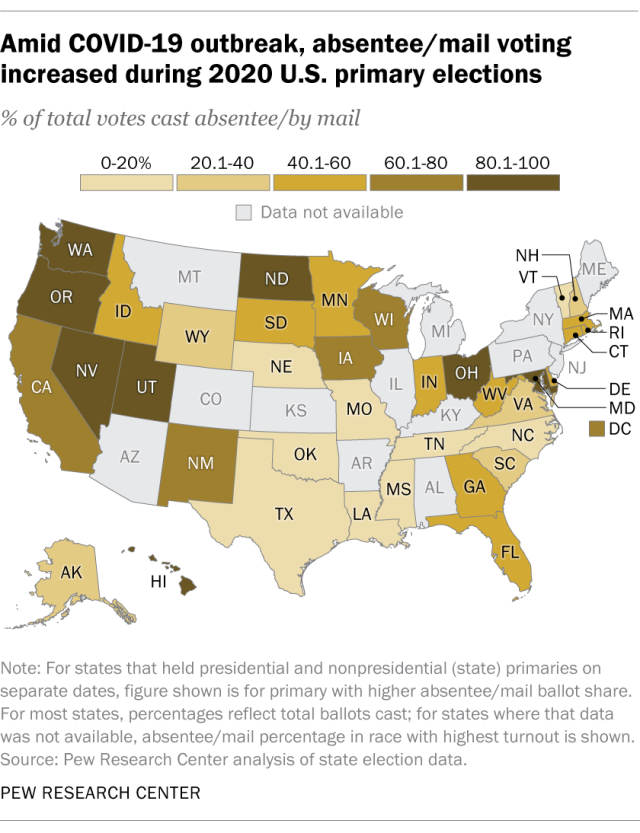
Mail-in voting – often called absentee voting or vote-by-mail – has slowly but steadily gained in popularity in the United States. And it received a big boost this year as primary season ran head-on into the novel coronavirus pandemic. Mail-in ballots accounted for just over half of this year’s primary votes cast in the 37 states (plus the District of Columbia) for which data is available. That was roughly double the mail-in share of the vote in those same jurisdictions in the 2018 and 2016 general elections.
In all, 26.6 million mail-in votes were cast in the 49 presidential, state and combined primaries that the Center examined for 2020, out of nearly 53 million total votes. (Some states held stand-alone presidential primaries and their regular state primaries at a later date; others combined them all on a single date.) The actual totals are almost certainly bigger, since some of the states for which detailed data isn’t available – including Colorado, Arizona and Montana – historically have had high rates of mail-in voting.
Pew Research Center conducted this analysis to quantify how prevalent mail voting (also referred to as absentee voting) became during the primary 2020 season, compared with the two most recent general elections in 2018 and 2016. We were able to obtain 2020 primary data from 37 states and the District of Columbia, either from the websites of the state elections authorities or, when those weren’t available, on direct inquiry to state officials. Data for 2018 and 2016 came from the Election Administration and Voting Survey, conducted every two years by the federal Election Assistance Commission.
For 2020, when presidential primaries and primaries for other offices were held on separate dates, we tried to get data on both. In most cases, states provided data on the total number of ballots cast in the primary. When those figures weren’t available, we typically used the race that attracted the most voters.
As the National Conference of State Legislatures points out, ballots sent to voters and voted somewhere besides a polling place have traditionally been called “absentee ballots.” But as more and more states have made such ballots easier to get – in five states they are now the default way of voting – they are increasingly referred to as “by-mail ballots” or some variation thereof. (The word “mail” indicates how the ballots are distributed to voters; they typically can be returned by mail or dropped off at an election office, drop box or some other authorized place.)
In 2018, 27.4% of the 85.4 million general-election votes in the same 38 jurisdictions were mail ballots. In the 2016 general election, 24.9% of that year’s 96.8 million were.
The mail shares in 2018 and 2016 were only slightly lower when all 50 states were included – 25.6% and 23.4%, respectively. (This analysis compares voting in this year’s primaries to general election voting in the past two election cycles. It’s possible that primary voters may differ in some systematic way from general election voters in terms of the method they choose to vote.)
On one hand, this year’s surge in mail-in voting continues a years-long trend. But the magnitude of the increase also reflects people’s concerns about voting in person during the COVID-19 pandemic and changes states made to their voting laws and procedures in response to the pandemic.
As the scope and seriousness of the pandemic became clear this spring, many states hurriedly shifted their presidential and state primaries to push for – or in some cases require – voting by mail. Mail ballots accounted for more than half the votes cast in 21 of the 49 presidential, state and combined primaries for which detailed vote breakdowns were available.
It seems likely that mail voting also will account for a large share of this fall’s general election vote. Even as President Donald Trump has raised concerns about the fairness and security of mail-in balloting (for which multiple studies have found little evidence), many states are strongly encouraging their citizens to vote that way.
California, Nevada, New Jersey and Vermont are mailing ballots to all registered voters, as are most of Montana’s counties and the District of Columbia. They join five other states that had already shifted to all-mail elections before the coronavirus outbreak: Colorado, Hawaii, Oregon, Utah and Washington state. (All of those jurisdictions except Oregon will also offer limited in-person voting, although they are encouraging voters to either mail back their ballots or drop them off at secure locations.)
A dozen other states are mailing every registered voter a vote-by-mail application as a way of encouraging them to choose mail voting over heading to the polls. In several other states, at least some counties are doing the same thing.
Big increases in mail voting
For most of the 38 jurisdictions in this analysis, the 2020 primary season represented a big leap in the use of mail voting. In 29 states and D.C., the vote-by-mail share of this year’s primary vote exceeded the levels set in those places in 2018 and 2016.
In several states, the share of voters who cast their ballots by mail rose dramatically this year. In Nevada, for example, 98.4% of the more than 491,600 votes cast in the June 9 state primary were mail ballots, compared with less than 9% in the 2018 general election. In Rhode Island, the mail-voting share rose from less than 5% in the 2018 general election to 83% in the June presidential primary. (By September’s statewide primary, however, the mail-voting share in Rhode Island had fallen to 42.7%).
The COVID-19 pandemic has had a clear effect on mail voting patterns this year. The average by-mail share of the vote in primaries held before March 13 – when Trump declared the pandemic a national emergency – was 11.3%. For the primaries held after that date, the average was 51.5%. (In both cases, we excluded primaries held in the all-mail voting states of Hawaii, Oregon, Utah and Washington; we didn’t have figures for Colorado, another vote-by-mail state.) In Massachusetts, the change was particularly striking: 47.7% of votes in September’s state primary were mail ballots, up from 3.3% in the March presidential primary.
Partisan differences in support for mail voting
Support for mail voting appears strong, but there are wide partisan differences. About two-thirds of Americans (65%) say the option to vote early or absentee should be available to any voter without requiring a documented reason, according to a June Pew Research Center survey. Democrats and Democratic-leaning independents were about twice as likely as Republicans and GOP leaners to support “no excuse” absentee or early voting (83% vs. 44%).
In a separate Center poll conducted in late July and early August, 39% of registered voters said they would prefer to vote by mail for the November election, while 40% said they’d prefer to vote in person on Election Day. (Another 18% of registered voters said they’d prefer to vote early in person.) Around six-in-ten supporters of Joe Biden (58%) said they prefer to vote by mail, compared with just 17% of Trump supporters.
There’s some evidence to support survey findings that Democrats are more likely to vote by mail than Republicans, though it’s limited because not all states register voters by party or make party vote breakdowns readily available. In 19 of the 24 primaries (in 18 states and D.C.) where Pew Research Center found partisan breakdowns, the mail-in share of the vote was higher on the Democratic side than on the Republican – often substantially so.
In New Hampshire’s state primary last month, for example, 42.4% of Democrats cast their votes by mail, versus 16% of Republicans. In Rhode Island’s primaries for U.S. House seats, also last month, 47.4% of Democratic ballots – but only 13.2% of Republican votes – were cast by mail, a difference of 34.2 percentage points.





